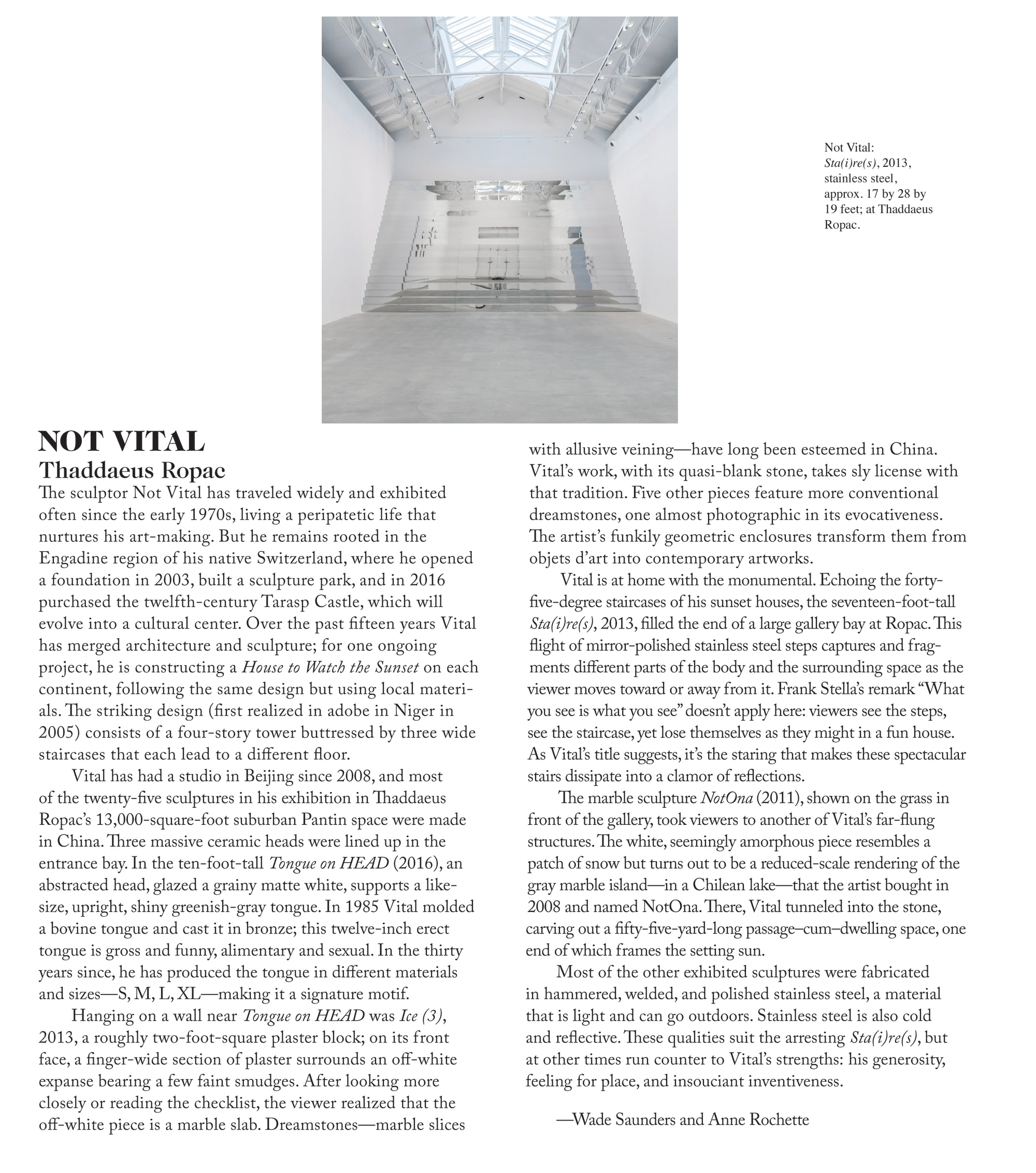
NOT VITAL

The sculptor Not Vital has traveled widely and exhibited often since the early 1970s, living a peripatetic life that nurtures his art-making. But he remains rooted in the Engadine region of his native Switzerland, where he opened a foundation in 2003, built a sculpture park, and in 2016 purchased the twelfth-century Tarasp Castle, which will evolve into a cultural center. Over the past fifteen years Vital has merged architecture and sculpture; for one ongoing project, he is constructing a House to Watch the Sunset on each continent, following the same design but using local materials. The striking design (first realized in adobe in Niger in 2005) consists of a four-story tower buttressed by three wide staircases that each lead to a different floor.
Vital has had a studio in Beijing since 2008, and most of the twenty-five sculptures in his exhibition in Thaddaeus Ropac’s 13,000-square-foot suburban Pantin space were made in China. Three massive ceramic heads were lined up in the entrance bay. In the ten-foot-tall Tongue on HEAD (2016), an abstracted head, glazed a grainy matte white, supports a like-size, upright, shiny greenish-gray tongue. In 1985 Vital molded a bovine tongue and cast it in bronze; this twelve-inch erect tongue is gross and funny, alimentary and sexual. In the thirty years since, he has produced the tongue in different materials and sizes—S, M, L, XL—making it a signature motif.
Hanging on a wall near Tongue on HEAD was Ice (3), 2013, a roughly two-foot-square plaster block; on its front face, a finger-wide section of plaster surrounds an off-white expanse bearing a few faint smudges. After looking more closely or reading the checklist, the viewer realized that the off-white piece is a marble slab. Dreamstones—marble slices with allusive veining—have long been esteemed in China. Vital’s work, with its quasi-blank stone, takes sly license with that tradition. Five other pieces feature more conventional dreamstones, one almost photographic in its evocativeness. The artist’s funkily geometric enclosures transform them from objets d’art into contemporary artworks.
Vital is at home with the monumental. Echoing the forty-five-degree staircases of his sunset houses, the seventeen-foot-tall Sta(i)re(s), 2013, filled the end of a large gallery bay at Ropac. This flight of mirror-polished stainless steel steps captures and fragments different parts of the body and the surrounding space as the viewer moves toward or away from it. Frank Stella’s remark “What you see is what you see” doesn’t apply here: viewers see the steps, see the staircase, yet lose themselves as they might in a fun house. As Vital’s title suggests, it’s the staring that makes these spectacular stairs dissipate into a clamor of reflections.
The marble sculpture NotOna (2011), shown on the grass in front of the gallery, took viewers to another of Vital’s far-flung structures. The white, seemingly amorphous piece resembles a patch of snow but turns out to be a reduced-scale rendering of the gray marble island—in a Chilean lake—that the artist bought in 2008 and named NotOna. There, Vital tunneled into the stone, carving out a fifty-five-yard-long passage–cum–dwelling space, one end of which frames the setting sun.
Most of the other exhibited sculptures were fabricated in hammered, welded, and polished stainless steel, a material that is light and can go outdoors. Stainless steel is also cold and reflective. These qualities suit the arresting Sta(i)re(s), but at other times run counter to Vital’s strengths: his generosity, feeling for place, and insouciant inventiveness.

Not Vital: Sta(i)re(s), 2013, stainless steel, approx. 17 by 28 by 19 feet; at Thaddaeus Ropac.